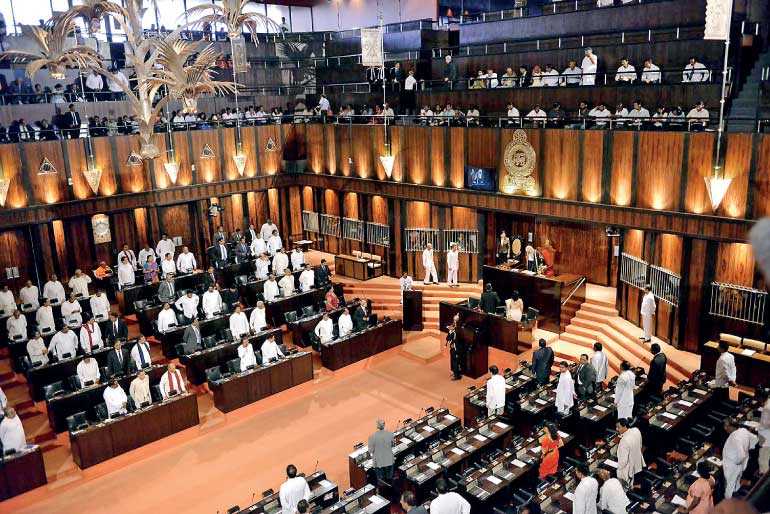Friday Mar 14, 2025
Friday Mar 14, 2025
Wednesday, 18 April 2018 00:02 - - {{hitsCtrl.values.hits}}

No administrative reforms are possible without the discipline and resolve of the Government to implement a ‘scientifically’ determined action plan
It has been reported that the new Cabinet of Ministers will be determined according to “scientific principles”. Erstwhile colleagues and friends, who found my March 2014 article on the same theme quite useful, have urged me to offer some fresh advice. I told them that I do not like to become a joke, once again, offering unsolicited advice to politicians. Their plea, however, was that I provide insights at least for the benefit of civil society, which is very concerned about the current state of affairs.
Cabinet size and structure is very much linked to the role of government and style of governance, particularly the scope of functions to which ministers must confine themselves. They should be concerned with policy making and implementation and not arrogate to themselves administrative functions which should be the responsibility of ministry secretaries and their subordinate staff.
Too large a cabinet certainly adds to costs and also creates confusion. It makes coordination ineffective. Fragmentation and duplication of functions among ministries exacerbate the situation. According to the 19th Amendment to the Constitution the number should not exceed 30 ministers unless it is a national government, which though is not clearly defined.
Ideally, the cabinet structure must follow the principle of inter-sectoral and intra-sectoral coordination. For instance, agriculture (crops), lands and irrigation policies and functions must be coordinated by one minister. The plantation sector can stand on its own, in view of its unique system of management and skills requirement. In most countries industry and trade are together, in view of their linkages.
Time and space do not permit a detailed discussion of portfolio distribution. The table suggests a feasible arrangement, which is based on lessons learnt by the writer, in particular, during his 11-year stint in charge of the National Planning Department and as Secretary of the Committee of Development Secretaries chaired by the legendary G.V.P. Samarasinghe.
It would be noticed that there are two new ministries – the Ministry of Administrative Reforms and the Ministry of Development Monitoring and Evaluation.
The Sri Lankan economy has reached an impasse blocked by structural problems. These blockades could be effectively removed only by a vibrant public service. It is a popular cliché that while the private sector is the engine of growth, the engine driver is the Government, in which the public service is the foundation. This factor was recognised 30 years ago, when the situation indeed was far better. It is why the national planning department took the initiative of setting up the Wanasinghe Committee with the support of Ronnie de Mel who was able to convince an unenthusiastic President Jayewardene of the need.
That Committee published a 10-volume report along with guidelines for effective action. It warned, in its preamble, against piecemeal, ad hoc implementation of its recommendations saying that it would be “not only counterproductive but also dangerous” to do so. Yet, that is exactly what happened and the public administration system in this country has become a lame duck far behind not only where it was 30 years ago but also contemporary regional countries.
The writer himself had the privilege of being a member of all administrative reforms committees since 2002 and the only outcome was that loads of reports were prepared by experts which educated all of us on what should be done but never done.
One lesson that all those involved in the process have learnt is that no administrative reforms are possible without  the discipline and resolve of the Government to implement a ‘scientifically’ determined action plan. For this reason, it is recommended that administrative reforms should be handled by a dedicated ministry under the Prime Minister, who will establish and pursue key performance indicators with the help of his cabinet colleagues using an IT-based management information system.
the discipline and resolve of the Government to implement a ‘scientifically’ determined action plan. For this reason, it is recommended that administrative reforms should be handled by a dedicated ministry under the Prime Minister, who will establish and pursue key performance indicators with the help of his cabinet colleagues using an IT-based management information system.
Similarly, a new Ministry of Development Monitoring and Evaluation should be established under the President to keep the ministers on their toes. The techniques are well known and are based once again on an IT based management information system.
While the cabinet size is confined to 30 members, including the President and the Prime Minster, what should be the number of deputy ministers? Small is not always beautiful. There are a number of ministries where more than one deputy minister is required to provide the necessary leadership.
A good example is the Ministry of Agriculture, Lands, Irrigation and Mahaweli Development which will have to organise itself under four deputy ministers. Similarly, the Ministry of Public Administration, Home Affairs, Provincial Councils and Local Government will also need four deputy ministers. On this basis, the Government will have to appoint about 60 deputy ministers.
These deputies, however, must have clearly-defined functions and areas of responsibility for which they are held accountable. Each deputy minister should be assisted by an additional secretary who ultimately reports to the secretary of the ministry. In order to limit expenditure, which is one of the main concerns of those advocating small sized cabinet of ministers, a deputy should not be allowed to have more than one private secretary, no coordinating secretary and only two cars for personal use. The personal security staff also should be kept to a minimum.
Cabinet performance, as well as that of the deputy ministers, is very much related to the quality and support provided by the ministry secretaries. It is unrealistic to expect all ministers to be specialists in their respective fields. It never happened in Sri Lanka and never happens anywhere else in the world, perhaps to some extent in Singapore.
Ministers are essentially politicians who have to be appropriately briefed on matters of concern to them so that they bring to bear their political knowledge. The responsibility in keeping the ministers, as well as the deputy ministers, well-informed lies with the secretary who has to organise the ministry functions in a way information is readily available. This is where modern management information systems become useful.
What has been offered above is a short note on the basic issues that may be taken into account by those who will be concerned with a ‘scientific approach’ to establishing a new cabinet. It is hoped that the scepticism expressed by an eminent retired public servant, at the end of his comments on the March 2014 article, does not come true, with the new approach. He said: “Anyway, at the end of all this one wonders why we should bother at all because rationality will be the least of the factors that will determine the final outcome – both in cabinet making and cabinet functioning.”
(The writer can be contacted via [email protected].)
Discover Kapruka, the leading online shopping platform in Sri Lanka, where you can conveniently send Gifts and Flowers to your loved ones for any event including Valentine ’s Day. Explore a wide range of popular Shopping Categories on Kapruka, including Toys, Groceries, Electronics, Birthday Cakes, Fruits, Chocolates, Flower Bouquets, Clothing, Watches, Lingerie, Gift Sets and Jewellery. Also if you’re interested in selling with Kapruka, Partner Central by Kapruka is the best solution to start with. Moreover, through Kapruka Global Shop, you can also enjoy the convenience of purchasing products from renowned platforms like Amazon and eBay and have them delivered to Sri Lanka.
Discover Kapruka, the leading online shopping platform in Sri Lanka, where you can conveniently send Gifts and Flowers to your loved ones for any event including Valentine ’s Day. Explore a wide range of popular Shopping Categories on Kapruka, including Toys, Groceries, Electronics, Birthday Cakes, Fruits, Chocolates, Flower Bouquets, Clothing, Watches, Lingerie, Gift Sets and Jewellery. Also if you’re interested in selling with Kapruka, Partner Central by Kapruka is the best solution to start with. Moreover, through Kapruka Global Shop, you can also enjoy the convenience of purchasing products from renowned platforms like Amazon and eBay and have them delivered to Sri Lanka.